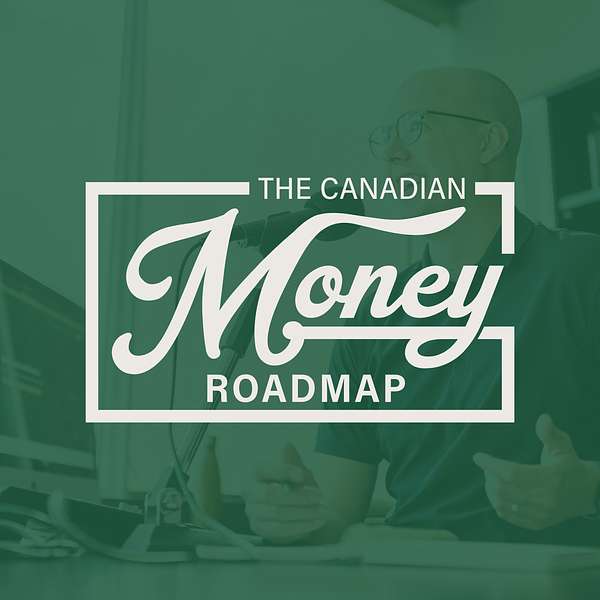
The Canadian Money Roadmap
Invest smarter, master your money, live & give more
The Canadian Money Roadmap
Discovering the Truth behind Investment Returns
Ever wondered how two seemingly identical investments can lead to dramatically different outcomes? Ready to decode the mysteries of investment returns? Buckle up as we embark on an enlightening journey. We'll dissect three hypothetical ten-year scenarios that, on the surface, appear to have identical returns, but when examined closely, reveal radically divergent investment narratives.
Gain a firm grasp on the role that rate of return and standard deviation play in investment analysis. We'll expose the critical impact that volatility has on your path to investment returns. You'll also gain insights into personalized investment returns, shedding light on money-weighted returns, an essential measure of average return per dollar invested. We’ll dissect the differences between time-weighted returns, and examine the profound implications of the sequence of returns on your portfolio. We'll present two unique 10-year scenarios with identical average returns, but contrasting end results, to visualize these concepts.
Lastly, we'll delve into the stock market's rollercoaster ride through the gripping saga of Carvana, a company that's seen dramatic peaks and valleys since it went public. Get set to understand the importance of context of when and why you invested.
Want a personalized retirement plan?
Retirement Readiness Scorecard 🇨🇦
Get your money organized - Your Full Financial Picture Spreadsheet
Hello and welcome back to the Canadian Money Roadmap podcast. I'm your host, evan Neufeld. On today's episode, we are taking a look at the numbers and we're looking at ways that you can better understand your rate of return and why sometimes the numbers might actually be lying to you. Welcome back to another episode here. This is the first time you are joining us on the podcast. Welcome here If you're listening to this episode and you've not joined the newsletter head over there. It's free and it's called Fully Invested and it is all about ways to improve your odds of success using evidence-based strategies for Canadians. There's no hype, there's no stock picking, there's no crypto. These are just better ways to understand the investing world in ways that you can actually take action on and build a reliable portfolio for yourself or through an advisor, or however you like to do it. Okay, today's episode. Unfortunately, I have recorded it before and I had a co-host, my colleague down the hall, stephen Gunther. He joined me for this one. It was a nice conversation but, for whatever reason, I had an issue with my recording software. So here I am recording it again. I'll have to get Stephen on another episode in the future. So when we talk about investing, the biggest thing that comes up, of course, is the rate of return and understanding how much money you can actually make from an investment. The trouble is there's always more to the story and a little bit more context. That's required to better understand either what you're reading as a rate of return for the investment itself or what your personal rate of return is for your own investments. Sometimes these can be very different from each other and looking at them in a vacuum without understanding the reasons why they might look different or even understanding why the same number might be telling a different story, is really important. So let's take a look at a high level here and just discuss how a specific number doesn't tell the whole story. So on the podcast here I often use a rate of return figure of 6%. I often use the language of an average of 6%, and even that even on my own podcast I'm not really telling the whole story here. So let's give some examples so you can kind of see what I mean. So if an investment had a return of 6% in any given year, that means, say you start with $10,000 in the first year, you would have $10,600 after you count for the 6%, then the next year, if you get 6% again, you would have $11,236, right, because you have compound growth. That's happening there. The growth grows on the growth. It's a. Most people understand this as compound interest. This is a big bugaboo of mine. Interest is a specific payment, not necessarily the increase in value on an investment. I like to use the term of compound growth instead of compound interest because it's more comprehensive, but I digress here. So if you have an investment that grows by 6% per year, every single year, for 10 years or 20 or whatever the case is, but it doesn't go up, it doesn't go down, it's the same amount every year, you would have an average of drumroll, please. 6%. It doesn't go up, it doesn't go down, it's the same amount every single year. Getting such an investment is going to be impossible. I'll just put that out there, but these are just hypothetical numbers that I'm going to be using. Okay, so that is one way that you can average 6%. Another way that you could average 6% could be if you get 6% in one year, 12% in the next, and then zero, and then six, then 12 than zero, then six, then 12 than zero, and six. Over the course of that ten-year period. You'd still average six percent. Some years average, some years nothing, some years really good, but you still average six percent. Now, in another world, we introduce a little bit more, what we call volatility, and volatility is the idea that, even though you could average six percent, every given year is probably going to be very, very different than that six percent. So here's another hypothetical ten-year scenario. Say, your first year give 19% and then negative 12 and 18, then you lose 29 percent, then you gain 45, then 38 and you lose 24 and 17 and 28 and you lose 40 percent in the last year. Believe it or not, all of those do average out to six percent again. However, the road to get to that six percent is very, very Bumpy. So are all six percent average returns created equally based on this Hypothetical scenario of those three different ways that we can get to six percent on average? No, these are very, very different. So how do we actually quantify that? Well, in the investing world, we often use a statistic called standard deviation. I won't get into the math there, but it's just the idea that the greater the standard deviation, the more volatile your returns are going to be over time. I don't like to use standard deviation on its own. It's valuable to compare your rate of return Alongside the standard deviation so you can see what that investment has returned and what story it told along the way. So let's go back to my three scenarios here. Six percent every year for ten years doesn't go up, it doesn't go down. That means you've averaged six percent with zero percent standard deviation, so no volatility at all. In the next scenario six twelve zero, six twelve zero, six twelve zero you average six percent, but your standard deviation is four point nine. Okay, so this would be in the ballpark of the level of volatility you would often get from, say, a bond fund. That's probably a little bit lower volatility and a little bit higher returns, but you know, just so you can kind of put it into context. Then in my other scenario, the 19 negative, 12, 18 minus 29 you know all over the place that same average of six percent, but with a standard deviation of twenty nine point nine. So let's call it 30 percent standard deviation. Using these two metrics together we can come up with a general idea of risk adjusted returns. Risk is a multifaceted concept that I'm not gonna flesh out here, but one metric of risk that people use is volatility, right? So if you want to get six percent or you expect six percent from your investment, but any given year could be all over the map, that would be a higher risk way to get to that six percent. So I'm not advocating one or the other necessarily being better, because everything Comes down to one's own personal circumstances and timelines and goals and everything else. But just so you can understand that when you hear a rate of return, it's just one metric that is important for understanding the context or the story of that specific investment. In my case here, one is very, very volatile and bouncy all over the place, perhaps lots of fear and and excitement, and this is your white-knuckle ride, and then something that's a little bit more of a Sunday cruise, and then something else that's going for a leisurely walk, right. So each different scenario Will have a different process and a different journey and a different story that it tells and that's usually the standard deviation story, even if the end result and the end destination is exactly the same. Okay. So now that is the idea of average rate of return, standard deviation and risk adjusted returns. Okay, we've got lots of concepts. We're going on here. Next one takes that average rate of return and let's make it personal. So how many of you listening have $100,000 invested and you put it in all on one day and now you're going to sit back and watch it for the rest of your life? I'm going to say exactly zero of you, regardless of that figure. Right, because anyone that's an investor, generally speaking, invests based on their income, and you earn your income over time and so you invest over time. So if I put in some money five years ago and the market went up and down and COVID hit and all these different things that happened in the stock market in the last five years, versus some money that I put in yesterday, well what is my actual rate of return? Because the money that I put in yesterday has only had the chance to either Grow or fall with the market move that happened yesterday. Where's the money that I put in five years ago has grown and fallen, all along with all those different crazy things that have happened in the last Five years. And so to calculate your personal rate of return, you need to factor in when you put in money and how much you put in. So this is where the idea of something we call Money-weighted or dollar-weighted rate of return Really is the only thing that matters to an individual investor. So let's contrast that with the two types of return that I've talked about already. What I was introducing in the first part of this podcast was the idea of time-weighted returns. So just looking at an investment's return over a period of time, what did that investment do, regardless of when money went in? But once we start introducing people and actual investors into the conversation, this is where we need to look at money-weighted returns, and this looks at your average return per dollar Invested, because not every dollar has been invested the whole time that you've been in that fund or in that stock or whatever the case is. This can be really complicated to calculate. However, for those of us in the investment industry on behalf of our clients in I think it was 2017, the rules actually changed and so that anyone that works with a financial advisor we actually have to report your money-weighted or dollar-weighted returns as opposed to your time-weighted, because it's much more applicable to you and very personalized and to your Situation. Many investment firms will still report time-weighted returns, and that's fine. However, you cannot compare your money-weighted returns to something else that's time-weighted. These are going to be different and almost every single time your time-weighted return is going to be better Than what you actually got in your money-weighted return. Even if you have perfect behavior and you didn't pull the money out when things got rough or anything like that, the fact of the matter is you just didn't have all of your money invested at the very beginning of your investing life, and so it's hard to get all the returns associated with the market when you haven't been invested the whole time. So if you're looking on Morningstar, if you're looking at an investment firms website, if you're looking at an ETF fax sheet or something like that, you might see these rates of return that look pretty good or look really good in some cases and then you look at your investment returns and say, oh man, mine have been really bad compared to what I can get here. However, when you look at those two numbers, one is telling your investment story and the other one is telling a completely different story. So just a word of caution here, to make sure you know what you're actually comparing to. There are some DIY investment platforms that are Generally reporting time-weighted returns instead of your actual money-weighted returns, making things look a little bit rosier than they actually are. So I would just be very, very cautious about comparing rates of return Until you know what type of return comparison you're making. Okay, let's recap so far. So we've talked about average rate of return generally, that's time-weighted. So what did investment do over a set period of time? Talk about standard deviation and how much that has Changed the returns in any given year, and when we compare those two, we can kind of come up with an idea of risk adjusted returns. What was our return versus how much volatility we took along the way? Then time-weighted returns versus money-weighted, and money-weighted Is your personal rate of return for that investment. Okay, another new concept I'm going to introduce here. It's called sequence of returns. So because you and I are investing on a regular basis every year, every month, every week or, for those of you listening, that are retired, or maybe your parents that are retired, or you know somebody and you're living off your investment portfolio, you're actually subtracting from your portfolio every single month or week or whatever you're doing. This is when the idea of money-weighted returns really, really matters, because the rates of return that you get in a specific order will really impact your overall return. I'm going to try to give you an example here that would be awesome in the visual format, but I'm going to try explaining it, so try to stay with me here. Okay, in my hypothetical scenario here, you're starting with a portfolio of zero and you're adding $5,000 a year for 10 years. Now I'm going to describe two investment return scenarios and how the average is going to be the same, but the end result is going to be very, very different. Okay, try to stay with me on this one. Okay, so you're adding $5,000 a year and in scenario number one it increases by 5% a year. Then in year two, you're adding another 5,000, then it goes up by 10%. Okay, so it goes up by 5, 10, and then I'm going to say 15%, 20, 25, then back down the mountain 20%, 15, 10, 5, and then in year 10, you lose half of it down 50%. Okay, so these are the returns in all the years here year one through 10, 5, 10, 15, 20, 25%, then 20, 15, 10, 5, minus 50. Pretty rough. Okay, this is very hypothetical. This has never happened before, but every year along the way, regardless of whether it was up or down, you added $5,000. So you started with zero and you put 50,000 in. So that's 5,000 a year for 10 years, and then at the end, in this case, even though you had positive returns for 9 out of 10 years, your account is worth 48,649 at the end of 10 years in this case. So you had an average rate of return time weighted of seven and a half. However, your money weighted return in this case was negative 0.6. Right, because it all matters when you put the money in and the sequence of returns. So we're kind of overlapping the idea of money weighted return and sequence of return. So you could have an investment that averages seven and a half percent per year on a time weighted basis, but because you're adding on a regular interval, your actual personalized money weighted return was negative. Okay, let's flip the returns on its head to find the inverse scenario. So in this case, or on those numbers again, it's down 50% in year one, and then 5, 10, 15, 20, 25, 20, 15, 10, and 5. Right, so the same average of seven and a half over the 10 year period, but the returns are inverted and you're still going to add $5,000 a month or, pardon me, $5,000 a year for 10 years. In this scenario, the average return was seven and a half, but your money weighted or compounded return was actually 14.7. And so you put in 50,000 in this case, but you end up with it value after the end of 10 years of over 100,000. And why was that the case? Well, the year in my hypothetical scenario where you ended up losing 50% was in the first year where you only had $5,000 invested. So the impact from a dollar perspective was much, much smaller because you lost $2,500. Whereas if the scenario was inverted and you lost that money in year 10, you lost nearly $50,000. So when you're adding or subtracting on a regular basis, the sequence of your returns matters and it impacts your money-weighted return, and that's really the only thing that matters for you as an individual investor. This is why most people, as they approach retirement, get a little bit more conservative, because the impact of a significant decline in their investment portfolio right before they need to start with drawing from it that flipping the switch from saving to spending that can have an outsized impact on their ability to actually sustain their portfolio over the course of their life. So as you get closer to retirement, getting a little bit more conservative makes a little bit more sense. Also, maintaining a little bit of risk throughout your whole life also makes sense, so that if you do have some of those declines at a bad time, you have the opportunity to regain them. That's another topic for another day. But hopefully you can see here through my scenario that even with an average of 7.5% ona time-weighted basis, someone's personalized or money-weighted returns could be anywhere from double that or none of that. All depends on when you put the money in and how long you let it go for. So the last concept that I'm going to talk about here is how the idea of percentages can kind of mess with our minds a little bit more and how losses can be more impactful than gains just on a percentage basis. So kind of like I showed there, if you have a significant decline right at the end of your investing life, that has a significant impact over a significant decline in the initial years of your investing life. But let's talk about the idea of how much your investment needs to regain after a significant decline. This is kind of an additional concept here that's not as pertinent to the idea of rate of return. But understanding percentages and how they impact your investment is important. So I'm going to talk about this one here. I'm going to lead with an example. You might have heard of this company called Carvana before. I don't think they have a Canadian presence. I think they're mostly in the US, but they advertise a lot and they're a company that ends up in the news pretty often. If you've ever been down to Phoenix, arizona, or near Tempe, that's where their headquarters is, and Carvana is an online car marketplace, I believe. So they'll buy a used car from you and then they'll sell it to somebody else, and so it's a bit of a buying and selling service for used cars. They're most famous for their car vending machines, where they've built these massive glass towers that have cars in them and they actually operate like a vending machine. It's more for publicity than any sort of revenue generating activity there, and they're very, very expensive. But anyways, this company has had a very, very volatile history since it has gone public. So back during the stock market craze of 2020, during COVID, companies like this really, really benefited, because the idea of buying a car just really threw people for a loop, because we couldn't buy cars anymore or new cars weren't being manufactured, and there was this huge backlog of people that needed a vehicle versus the cars that were available, and so companies like Carvana that were buying and selling used cars they were pretty much the only game in town. And so people just started bidding up these stocks, like just buying and buying and buying, regardless of how much revenue these companies had, because it's like, well, if the world's going to end, we can't buy new cars. Used cars are the only thing that we have. So, anyways, stock price went up to as high as about $360. That means nothing related to how much the company is actually worth, but I'm just going to use share price here so you can have an idea of where it went. So it got as high as $360. Then, when everybody realized that the world didn't end with COVID and cars started to be manufactured again and people realized that this company wasn't actually making any sort of profit not even close and interest rates were going up. So the crazy amounts of debt companies like Carvana had were now getting very, very expensive. Like, oh my goodness, we should not be owning this stock anymore. And so investors sold the stock like crazy. So it went from a high of 360 down to a low last year of $3.55. I will do the math for you. That is a decline of 99%. Okay, this company absolutely cratered. So if you bought it at $360 and you held it all the way to the end, you lost 99% of your money, the end being the bottom of the market late last year. Now, however, the companies kind of found their financial religion and then has been paying down their debt and trying to increase revenues, get closer to profitability. I don't know, I'm not going to advocate for the stock my name means but they have improved, and when I last looked at the share price versus the lowest price that it ever was, it was up hold on to your hat 1,350%. So it went from a low of $3.55 all the way up to $0.51 and 50 cents. But those of you that remember two minutes ago when I said the all-time high from the stock was 360 bucks, that is still a far cry from the current share price of 51. So if you bought at the all-time high and you're still holding on, you're still down 86%, even though the short-term returns have been over 1,300. This takes a little bit of mental gymnastics here. So percentages kind of throw people for a bit of a loop because you say oh my goodness, this stock is up 1,300%, this must be the best stock you could possibly own. Well, yeah, maybe. Like depends on when you bought it though, right. Investing is so much more about what you paid for something than what you actually bought. So if you bought this stock at 360 bucks, you're still within a rounding error of losing everything. But if you bought it at $3.55, you might be able to retire. So I'm not advocating for market timing by any means. Just the basic explanation of percentages don't tell the whole story either, because if you think that something is down a bunch, you just need to make that much to get even right. So if something is down 50% and then the stock is up 50%, you'd think you're back to even. Nope, because okay, so you start with $100 and it's down by 50%. That means you're down to 50 bucks. If you go up 50% from there, 50% of 50 is 25. So you're only back up to 75%. So when an investment declines by 50%, you actually need to get 100% just to get back up to even. So when we understand investing in these terms and how it relates to your own personal circumstance of when you invested and what you own and how long you're holding it for and what the purpose is you're holding it for. Percentages matter. You can't really act on a lot of it and you can't impact when the returns come, but you can participate and you can automate. You can make sure that you're there for whenever the returns do come and if you're getting closer and closer to needing to spend your money, take a little bit of risk off the table, because those losses at the wrong time are both unpredictable and very impactful. So we try not to time the market because we don't know the future. But my goal here was just to help you understand a little bit more about how rate of return can be used in context of the greater story of your investments. If this was interesting or helpful to you, I'd love to hear from you. Give me a shout in the show notes of this episode. My email is there. You can email me at hello at evannewfieldcom. I'd love for you to join the newsletter. I call it fully invested, trying to do it every week, and there's a lot of you that are there already. So thank you so much for all of you who are part of the newsletter. Sometimes a podcast format isn't as great for sharing things like graphs and charts and visuals and even just shorter versions of concepts. This newsletter won't take you an eternity to read. It'll be a couple of minutes every week, but I hope it'll be really valuable for you for increasing your odds of investing success over time. Thanks again for joining and for all of you who have left reviews and ratings recently. I really appreciate it and that helps us get on the podcast charts for more people to find the podcast. Thank you for sharing with your friends. Thank you for being here. Thank you for listening. I appreciate every single one of you and I will see you next week with another episode. Thanks for listening to this episode of the Canadian Money Roadmap Podcast. Any rates of return or investments discussed are historical or hypothetical and are intended to be used for educational purposes only. You should always consult with your financial, legal and tax advisors before making changes to your financial plan. Evan Neufeld is a certified financial planner and registered investment fund advisor. Mutual funds and ETFs are provided by Sterling Mutuals Inc.








